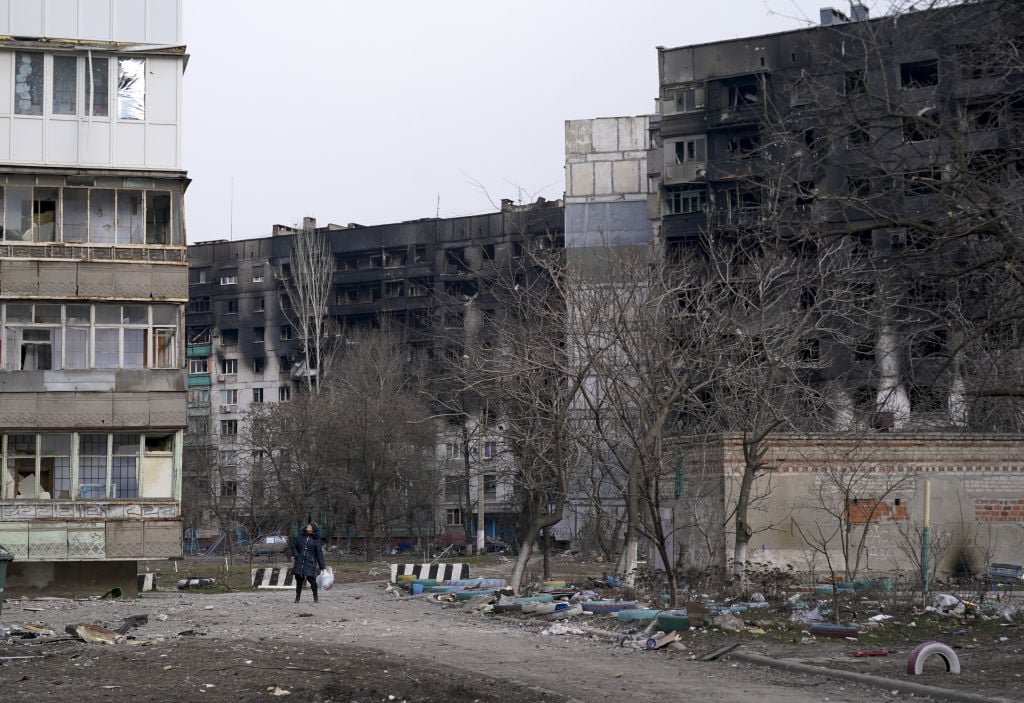
Widespread looting by Russian military of valuable artworks and historic collections of gold in Ukraine has taken place in recent weeks, according to several media and government sources.
Such activity appears to be particularly intense in Mariupol and Melitopol, southern cities that have both suffered devastating attacks by Russian forces. While there is little doubt that works have been taken or damaged on a massive scale, there has been considerable confusion and conflicting information about what has been successfully hidden away and what has been destroyed or stolen.
Ukrainian officials accused Russian forces of seizing more than 2,000 artworks from various museums in the city, and moving them to areas in the Donbas region that are under Russian control, according to a Friday report in The Guardian. The museums that have been targeted include the Kuindzhi Art Museum (destroyed on March 23), and the Mariupol Local History Museum. Video footage, including on NBC News, shows massive damage to the Mariupol history museum.
The Mariupol City Council posted information on its Telegram account outlining the thefts, which it said included work by 19th-century artist Arkhip Kuindzhi, and renowned Russian painter Ivan Aivazovsky as well as a unique handwritten Torah scroll, and the Gospel of 1811. “Mariupol city council is preparing materials for law enforcement agencies to initiate criminal proceedings and make an appeal to Interpol,” the government said, according to The Guardian. However, the newspaper included the caveat: “If confirmed, the art seizure in Mariupol would signify the first known instance of mass cultural looting by Russian forces since the start of the war.”
On Saturday, the New York Times reported that a valuable collection of gold artifacts at a museum in Melitopol, another Russian-occupied town in southern Ukraine, was spirited away last Wednesday in what it described as a “heist.” A museum caretaker described the group that seized the gold as a mysterious Russian-speaking man in a white lab coat, who showed up with “a squad of Russian soldiers [who] stood behind him, with guns, watching eagerly,” according to the Times.
But there appeared to be confusion about what had happened to the gold since some sources believed museum staff had successfully hidden away the collection for safekeeping. “There is no way to check information from Melitopol, which is a battlefield at the moment,” a source familiar with the situation told Artnet News.
According to the Times, the unidentified man in the white coat used long tweezers and special gloves to extract dozens of gold artifacts that are more than 2,300 years old, from cardboard boxes in the museum basement. The items are from the Scythian Empire and date back to the fourth century B.C.
“The orcs have taken hold of our Scythian gold.” Melitopol’s mayor Ivan Fyodorov told local media, using a common derogatory term for Russian soldiers. Fyodorov was abducted by Russian forces in early March and held captive before Ukrainian officials secured his release. “This is one of the largest and most expensive collections in Ukraine, and today we don’t know where they took it,” he added.
The theft of the historic gold is described as the most “brazen” act of the Russian invasion so far. Leila Ibrahimova, the director of the Melitopol Museum of Local History, told the Times that when Russian forces started shelling the region in late February, she and other museum workers secretly hid the gold and other important historic artifacts in cardboard boxes, “in a dank cellar where they didn’t think anyone would find it.”
In mid-March, however, Ibrahimova said Russian troops stormed her house and kidnapped her, subjecting her to intense questioning. After her release, she fled Melitopol.
Last week, according to the account, she received a call from a caretaker at the museum who said Russian soldiers, intelligence officers, and the man in the lab coat showed up at her house and forced her at gunpoint to go to the museum.
She said they pressured her to locate the Scythian gold and that she refused, but that they found it anyway, aided by Evgeny Gorlachev, a Ukrainian who was appointed by the Russian military as the museum’s new director. A Russian crew reportedly filmed part of the removal.
The stolen objects are believed to include at least 198 gold ornaments in the form of flowers, gold plates, as well as rare old weapons, 300-year-old silver coins and special medals.
Gorlachev, the new museum director, later appeared on Russian television saying that the artifacts “are of great cultural value for the entire former Soviet Union” and that the previous administrators of the museum “spent a lot of effort and energy” to hide them.